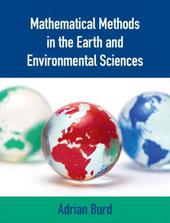
|
Mathematical Methods in the Earth and Environmental Sciences
Hardback
Main Details
| Title |
Mathematical Methods in the Earth and Environmental Sciences
|
| Authors and Contributors |
By (author) Adrian Burd
|
| Physical Properties |
| Format:Hardback | | Pages:596 | | Dimensions(mm): Height 254,Width 193 |
|
| Category/Genre | Earth sciences |
|---|
| ISBN/Barcode |
9781107117488
|
| Classifications | Dewey:550.151 |
|---|
| Audience | | Tertiary Education (US: College) | | Professional & Vocational | |
|---|
|
Publishing Details |
| Publisher |
Cambridge University Press
|
| Imprint |
Cambridge University Press
|
| Publication Date |
18 April 2019 |
| Publication Country |
United Kingdom
|
Description
The Earth and environmental sciences are becoming progressively more quantitative due to the increased use of mathematical models and new data analysis techniques. This accessible introduction presents an overview of the mathematical methods essential for understanding Earth processes, providing an invaluable resource for students and early career researchers who may have missed (or forgotten) the mathematics they need to succeed as scientists. Topics build gently from basic methods such as calculus to more advanced techniques including linear algebra and differential equations. The practical applications of the mathematical methods to a variety of topics are discussed, ranging from atmospheric science and oceanography to biogeochemistry and geophysics. Including over 530 exercises and end-of-chapter problems, as well as additional computer codes in Python and MATLAB (R), this book supports readers in applying appropriate analytical or computational methods to solving real research questions.
Author Biography
Adrian Burd is an associate professor at the Department of Marine Sciences at the University of Georgia. As a marine scientist, he applies mathematical tools to understand marine systems, including the carbon cycle in the oceans, the health of seagrass and salt marshes, and the fate of oil spills. His work has taken him around the globe, from the heat of Laguna Madre and Florida Bay to the cold climes of Antarctica.
|